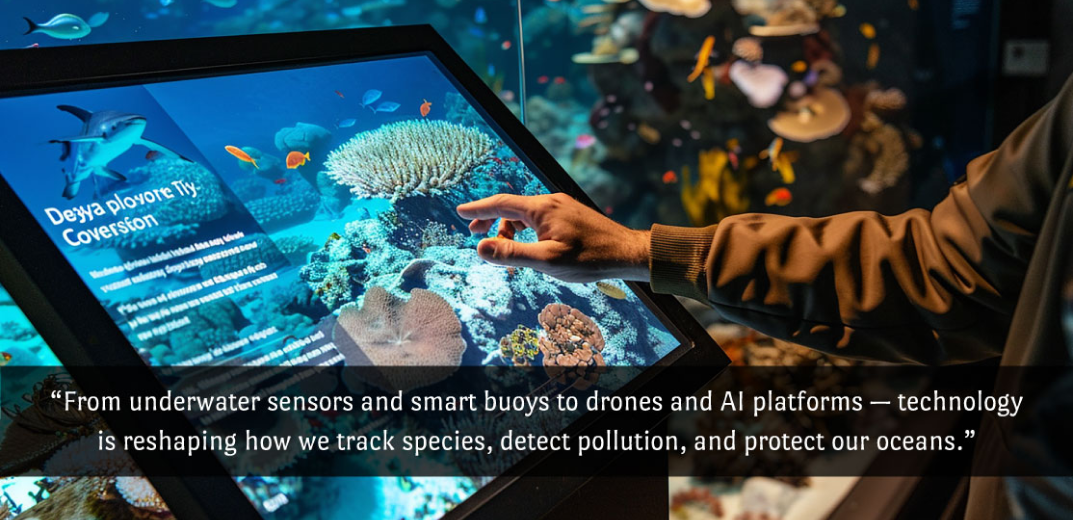From Species Tracking to Pollution Control: A Smart Approach to Ocean Protection
Featured Blogs
From Species Tracking to Pollution Control: A Smart Approach to Ocean Protection
Walk along any coastline today, and you’ll see the contrast: breathtaking beauty on one side, and the creeping signs of human impact on the other. Plastic waste, oil traces, coral bleaching, and dwindling marine life are no longer rare sights. The ocean, our planet’s largest ecosystem, is quietly sending distress signals. The challenge is clear — how do we protect something so vast, complex, and vital? The answer lies in a simple principle: you can’t protect what you can’t measure. And that’s where technology enters the story.
Categories

From Species Tracking to Pollution Control: A Smart Approach to Ocean Protection
Seeing the Invisible: Tracking Marine Life
A decade ago, marine biologists
relied on dive logs and luck to study ocean life. Today, the ocean speaks for
itself—through data.
- Hydrophones eavesdrop on
whale songs, identifying species by their unique `voices` (thanks to AI audio
analysis).
- 4K underwater cameras stream the
secret lives of coral reefs, detecting bleaching events before they spread.
- Drones with thermal vision spot sea turtle
nests hidden under sand, while eDNA sampling reveals invisible visitors—like
sharks or rare fish—from just a cup of seawater.
Each of
these devices is a storyteller — feeding data into a system that can reveal
migration patterns, biodiversity levels, and population changes. Even seawater
itself carries traces of DNA; through metabarcoding, we can detect species
presence without ever seeing them.
This isn’t just observation; it’s
a living
dashboard of ocean health, updated in real time.
How whole System works:
Fighting Pollution Before It Spreads
Pollution
doesn’t wait. An oil spill, a sewage leak, or a sudden algal bloom can
devastate marine life in days.
Here’s
where IoT-enabled monitoring flips the narrative from reaction to prevention:
- Smart buoys equipped with water-quality sensors continuously check
salinity, oxygen, and chemical levels.
- Drones fitted with infrared cameras detect oil slicks long before they
reach the shore.
- Fluorometry sensors identify fuel traces that the naked eye would miss.
Now
imagine all this data flowing into a central dashboard, where anomalies trigger
instant alerts. Instead of waiting for fishermen or tourists to report a
problem, authorities can act immediately — dispatching cleanup crews, enforcing
restrictions, or rerouting shipping traffic.
Pollution
is no longer an invisible enemy. It becomes measurable, trackable, and
manageable.
Safer
Oceans for People and Nature
"Every year, 300,000 whales and
dolphins die in ship collisions. Illegal fishing steals $23 billion from
coastal economies. Technology bridges the gap between ecology and safety:
- AI-powered vessel tracking red-flags ships
drifting into protected zones (like a maritime `speed camera`).
- Smart buoys broadcast whale
locations to nearby ships, reducing strikes by 80% in pilot projects.
- ROVs patrol underwater pipelines or reefs,
deterring poachers with 24/7 surveillance.
The result? Oceans where commerce and
conservation coexist."
Turning Data into Action
"Data is useless
unless it changes something.
Here’s how the puzzle comes together:
- Edge AI on
buoys filters noise—sending only critical alerts.
- Machine learning correlates
whale migrations with shipping lanes, suggesting reroutes.
- Dashboards translate
satellite, drone, and DNA data into one-click
reports for policymakers.
The goal? Replace
‘analysis paralysis’ with ocean
CPR—Conservation, Protection, Response."
So, How Results came into our eyes?
How We Approach It at Dotcom IoT LLP?
At
Dotcom IoT LLP, our work is built on one principle: data must lead to action.
We design end-to-end systems that combine rugged hardware, secure connectivity,
and powerful analytics into one seamless flow.
- Underwater sensors, drones, and smart buoys feed raw environmental data.
- IoT platforms handle secure device registration, updates, and
interoperability.
- Edge processing reduces response times, while cloud AI trains predictive
models.
- Dashboards translate complex datasets into clear, actionable views.
By
blending these components, we help organizations not just collect data but
truly understand and
act on it — protecting biodiversity, ensuring safety, and
enabling sustainable growth.
Towards “Smart Oceans”
The
story of marine conservation is just beginning. Tomorrow’s systems will
integrate block chain for tamper-proof marine data, AI for predicting species
migration shifts, and global platforms for shared ocean intelligence.
The goal? Smart Oceans — where every reef, every species, and every wave is connected, monitored, and protected in real time.
With
the right blend of science, data, and technology, the ocean’s story doesn’t
have to be one of decline. It can be one of resilience, balance, and hope.
“Smart oceans need smart systems.
Built and secured by Dotcom IoT LLP.”
Recent Post
Get In Touch With Us
Are You Ready To Grow Your Business With Us?
Drop us a message
- Dotcom IoT : Headquarter
FW 3040, Bharat Diamond Bourse, BKC, Bandra Kurla Complex, Mumbai Suburban, Mumbai, Maharashtra, 400051, India. - Dotcom IoT : R&D Centre
410/4th Floor, Sunshine Commercial Complex, Hans Society, Mota Varachha, Surat, Gujarat 394101. USA
20W 47th ST, Suite#1501-A New York, NY 10036-3735.South Korea
369, Sangdo-Ro, Venture Center, Soongsil Univ., Dongjak-Gu Seoul, South Korea.- +91 85919 00346
- sales@dotcom.co.in





Tag:
#IoTMarineConservation#SmartOceans#Marine Biodiversity TrackingShare:
Tanvi Kukadiya is a Business Development Executive at Dotcom IoT LLP, specializing in strategic content, B2B outreach, and market research for IoT-based solutions.